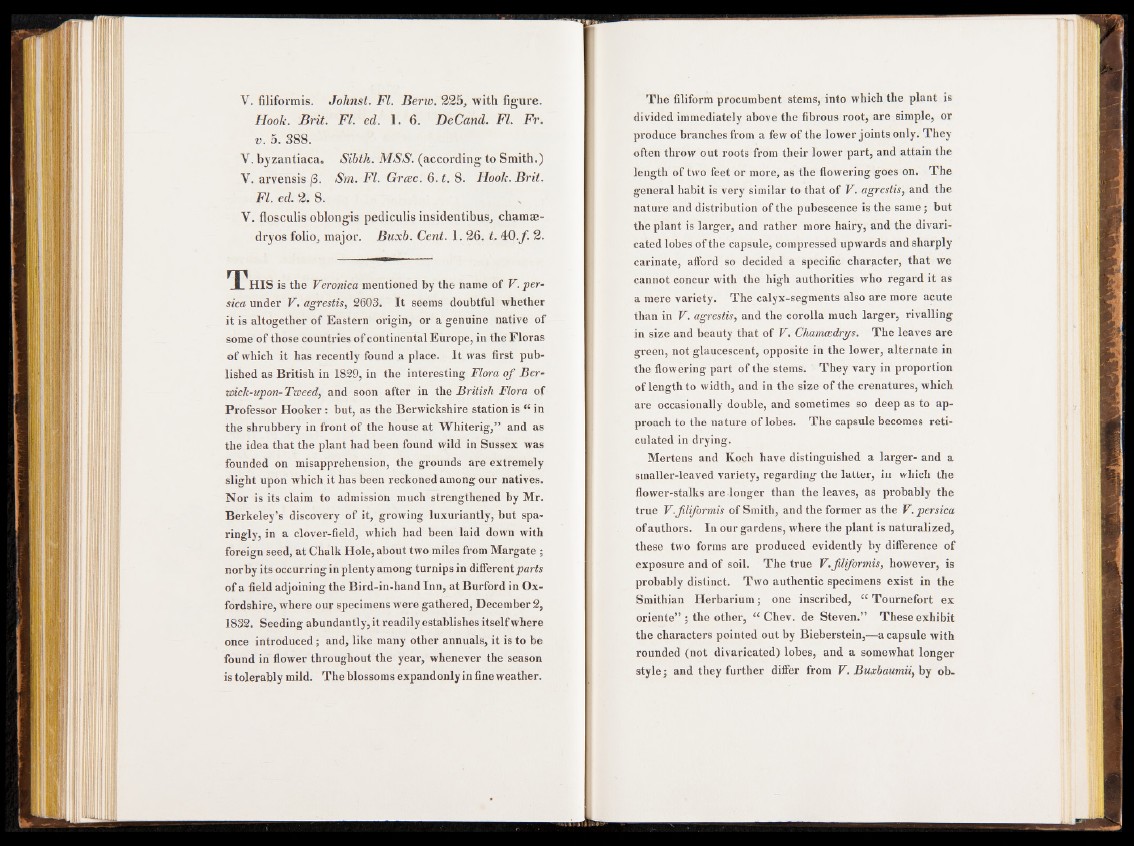
V. filiformis. Johnst. FI. Berw, 225, with figure.
Hook. Brit. FI. ed. 1. 6. DeCand. FI. Fr.
v. 5. 388.
V. byzantiaca. Sibth. MSS. (according to Smith.)
V. arvensis (3. Sm. FI. Grrec. 6. t. 8. Hook. Brit.
FI. ed. 2. 8.
V. flosculis oblongis pediculis insidentibus, chamae-
dryos folio, major. Buxb. Cent. 1.26. t, 40.f . 2.
T h i s is the Veronica mentioned by the name of V. per-
sica under V. agrestis, 2603. It seems doubtful whether
it is altogether of Eastern origin, or a genuine native of
some of those countries of continental Europe, in the Floras
of which it has recently found a place. It was first published
as British in 1829, in the interesting Flora o f Berwick
upon-Tweed, and soon after in the British Flora of
Professor Hooker: but, as the Berwickshire station is fC in
the shrubbery in front of the house at Whiterig,” and as
the idea that the plant had been found wild in Sussex was
founded on misapprehension, the grounds are extremely
slight upon which it has been reckoned among our natives.
Nor is its claim to admission much strengthened by Mr.
Berkeley’s discovery of it, growing luxuriantly, but sparingly,
in a clover-field, which had been laid down with
foreign seed, at Chalk Hole, about two miles from Margate ;
nor by its occurring in plenty among turnips in different parts
of a field adjoining the Bird-in-hand Inn, at Burford in Oxfordshire,
where our specimens were gathered, December 2,
1832. Seeding abundantly, it readily establishes itself where
once introduced; and, like many other annuals, it is to be
found in flower throughout the year, whenever the season
is tolerably mild. The blossoms expandonly in fine weather.
The filiform procumbent stems, into which the plant is
divided immediately above the fibrous root, are simple, or
produce branches from a few of the lower joints only. They
often throw out roots from their lower part, and attain the
length of two feet or more, as the flowering goes on. The
general habit is very similar to that of V. agrestis, and the
nature and distribution of the pubescence is the same; but
the plant is larger, and rather more hairy, and the divaricated
lobes of the capsule, compressed upwards and sharply
carinate, afford so decided a specific character, that we
cannot concur with the high authorities who regard it as
a mere variety. The calyx-segments also are more acute
than in V. agrestis, and the corolla much larger, rivalling
in size and beauty that of V. Chamcedrys. The leaves are
green, not glaucescent, opposite in the lower, alternate in
the flowering part of the stems. They vary in proportion
of length to width, and in the size of the crenatures, which
ai'e occasionally double, and sometimes so deep as to approach
to the nature of lobes. The capsule becomes reticulated
in drying.
Mertens and Koch have distinguished a larger- and a
smaller-leaved variety, regarding the latter, in which the
flower-stalks are longer than the leaves, as probably the
true V. filiformis of Smith, and the former as the V. persica
of authors. In our gardens, where the plant is naturalized,
these two forms are produced evidently by difference of
exposure and of soil. The true V.filiformis, however, is
probably distinct. Two authentic specimens exist in the
Smithian Herbarium; one inscribed, “ Tournefort ex
oriente” ; the other, “ Chev. de Steven.” These exhibit
the characters pointed out by Bieberstein,—a capsule with
rounded (not divaricated) lobes, and a somewhat longer
style; and they further differ from V. Buxbaumii, by ob